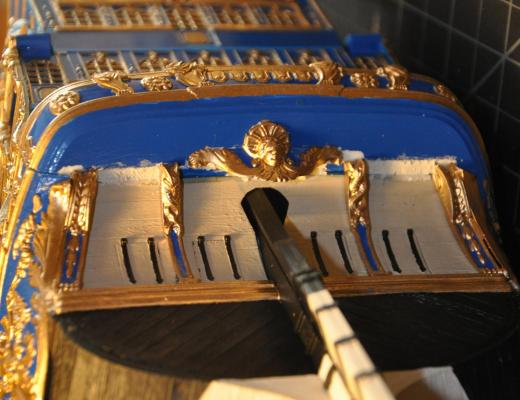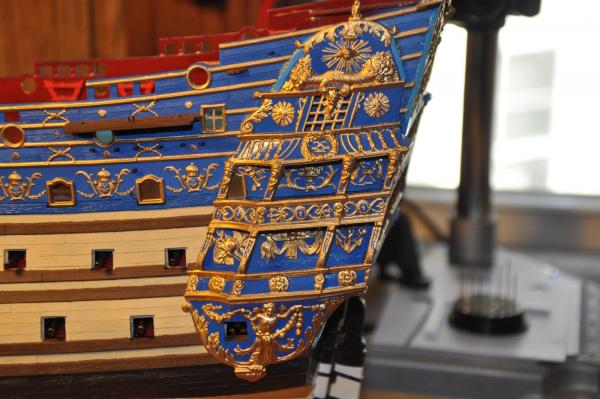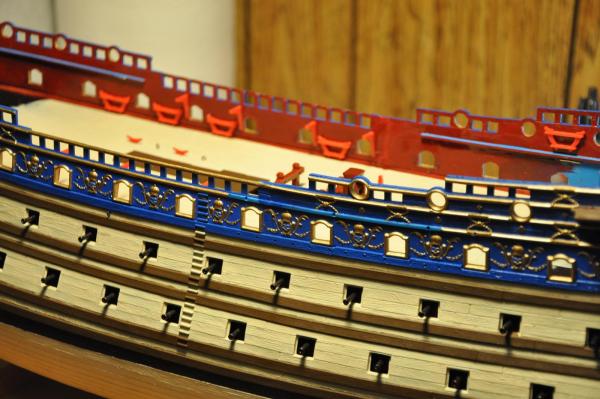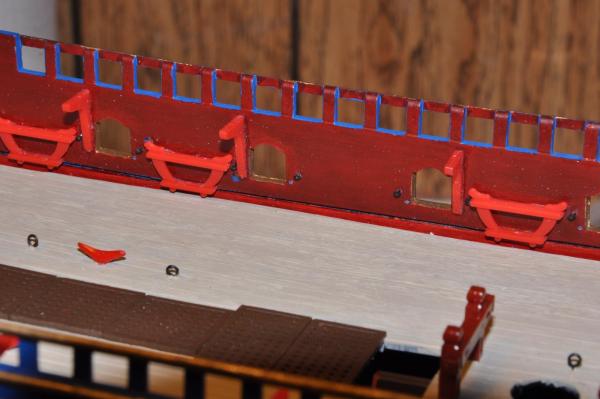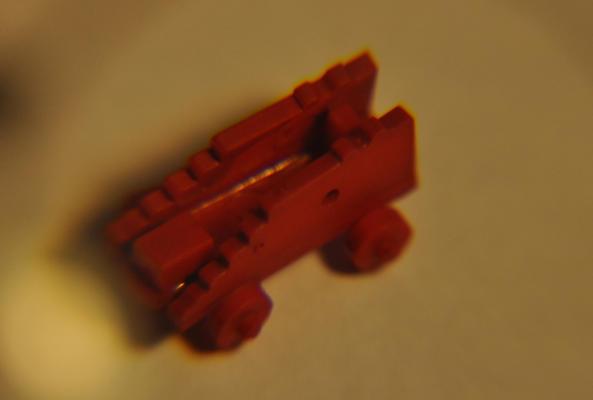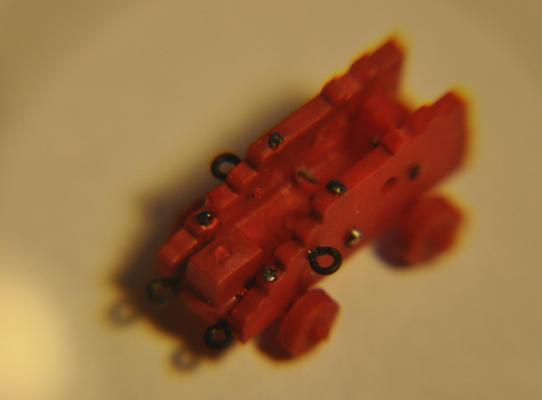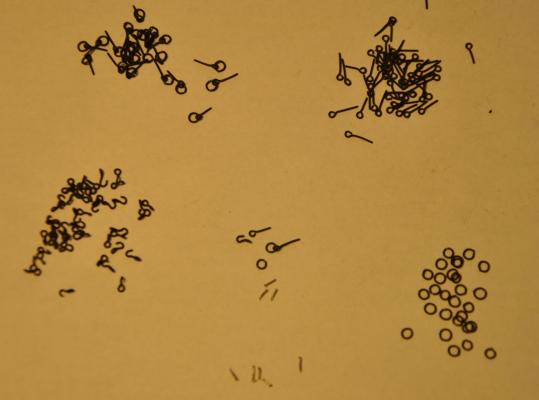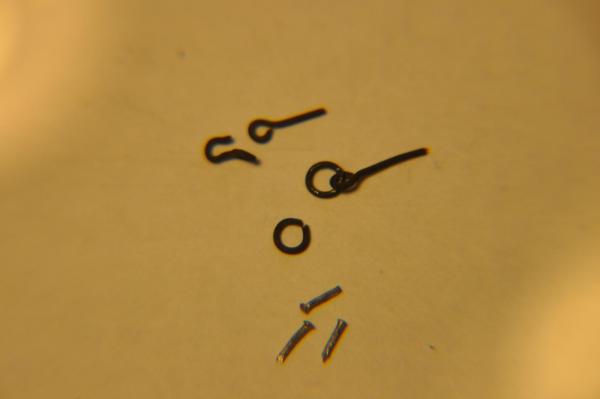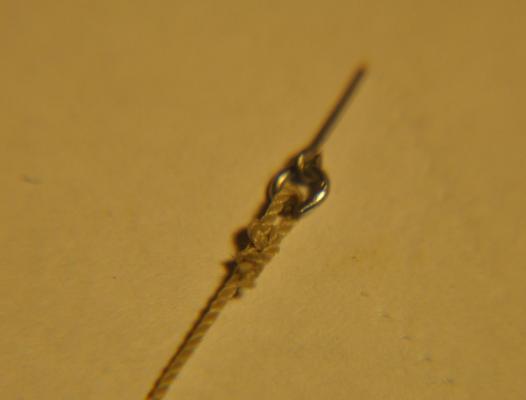-
Posts
1,935 -
Joined
-
Last visited
Content Type
Profiles
Forums
Gallery
Events
Everything posted by popeye2sea
-
Although it is a hazard to the crew there is nothing I can do about that loose cannon. And I am not about to go jiggling the model upside down on the hope that it falls out through a ladder well. But now people can actually call me a loose cannon
- 196 replies
-
- plastic
- soleil royal
-
(and 2 more)
Tagged with:
-
Interesting development last night..... I noticed that one of the cannons of the second battery had been knocked loose in the fall. It is now rattling around inside the ship - inaccessible. The only way to remount the gun is through the gun port. I had a few spare cannon assembled and painted from when I was working on that deck, but obviously it would not fit through the port. I dismounted the gun and took off the wheels. That gave me the clearance through the port. Then I made up the height difference by making a platform out of sheet styrene, inserted through the port and glued to the deck. Next came the gun carriage through the port and glued to the platform. Finally the gun was remounted through the port. The whole procedure reminded me of playing the game 'Operation' when I was a kid. Thanks for looking in on the build.
- 196 replies
-
- plastic
- soleil royal
-
(and 2 more)
Tagged with:
-
So...I was filling and painting the transom last night and the ship decided to slide down the ways on it's own and fell to the floor. (insert appropriate language here) The stem and figurehead broke off and the bowsprit was loosened, but intact. After re-entering the yards for repairs the stem and figurehead were repaired with no ill effects. I found, however, that the bowsprit had sheared off its step and would not re-seat. The beakhead bulkhead had to be removed to provide access to the step and a new one was fashioned to hold the foot of the bowsprit. I am happy to report that after a few hours of repair work everything is back to shipshape.
- 196 replies
-
- plastic
- soleil royal
-
(and 2 more)
Tagged with:
-
The stern on this kit does not go together very well. The alignments are off and very difficult. Once the quarter galleries and the lower stern balcony are affixed and lined up as well as possible there are still large gaps at the top of the transom and around the edges of the quarter galleries. Contour putty filled the gaps.
- 196 replies
-
- plastic
- soleil royal
-
(and 2 more)
Tagged with:
-
Daniel, yes the carriages are all made. I can still move the trunnions back a bit on the barrels. The eyebolt on the sides is for the gun tackle (it looks big in the picture). I have a hole drilled into the carriages for the breeching.
- 196 replies
-
- plastic
- soleil royal
-
(and 2 more)
Tagged with:
-
The quarter galleries have been fitted to the hull with their inset decorative motifs affixed to the inside.
- 196 replies
-
- plastic
- soleil royal
-
(and 2 more)
Tagged with:
-
The upper sides have been fitted to the hull. Still have to set and bend over some eyebolts for the chains to fasten to. The bent over ends will fall into the gap at the bottom of the upper sides. Then I will fill in the gap with contour putty. My thanks to HistoryGuySteve for the suggestion on fixing the dullcote dissapointment. Your solution worked well.
- 196 replies
-
- plastic
- soleil royal
-
(and 2 more)
Tagged with:
-
Gun Carriages. Before.....and after. Ready to be rigged. Not sure if I want to make trunnion covers.
- 196 replies
-
- plastic
- soleil royal
-
(and 2 more)
Tagged with:
-
Good to see all of you together. I hope I can get the chance to meet you again sometime.
- 196 replies
-
- plastic
- soleil royal
-
(and 2 more)
Tagged with:
-
Here is the product of all the hard work of the smith. All are made from 28 gauge steel wire blackened with Blacken-it. The small rivets/nails are not blackened yet. I am waiting till I get a pile of them made. They will be used to represent the bolts that hold the gun carriages together. I may be going a little overboard with these bolts. Each one is peened by hand and I am putting 8 on each gun carriage. The hooks and eyebolts were easy by comparison. I must be crazy....that's what the Admiral says
- 196 replies
-
- plastic
- soleil royal
-
(and 2 more)
Tagged with:
-
Your cannons look superb. I know what you mean about a lot of love and determination. I figure it's all part of the learning curve. If I can make 2mm blocks and rigging look good It will be easy for the larger sized rigging. My cannons should be completed in a few days. Then I can close up the decks and move on to the stern galleries and transom.
- 601 replies
-
- constitution
- revell
-
(and 1 more)
Tagged with:
-
Thanks for the compliments. The putty for the molds is from Castin' Craft. It's called Easy Mold (item # 33700). The casting resin is from the same company, called Easy Cast (item #33008). Both are very easy to use.
- 196 replies
-
- plastic
- soleil royal
-
(and 2 more)
Tagged with:
-
The blacksmith forge at the shipyard is working overtime making hooks, eyebolts, and ringbolts for rigging the cannons. The riggers (unfortunately they are all neophytes and apprentices) are working out the proper ways to rig everything in ship shape fashion. Here is the latest: Breeching Rope with ring bolt Thanks for looking in.
- 196 replies
-
- plastic
- soleil royal
-
(and 2 more)
Tagged with:
-
Happy Birthday my friend. Your blocks look great.
- 601 replies
-
- constitution
- revell
-
(and 1 more)
Tagged with:
-
I think I am going to go with a short piece of thread (not scale rope, too expensive to use for this purpose) with an overhand knot. The knot to be hidden at the base of the block between it and the strop. The tension of the strop against the block should hold the knot closed. That will allow me to use a becket bend to properly fasten the standing part of the tackle to the block. Perhaps with the larger blocks I'll try a proper grommet for the becket, but for the 2mm blocks it's just too much effort.
- 601 replies
-
- constitution
- revell
-
(and 1 more)
Tagged with:
-
Still working on my gun tackles also. Currently working out methods for making beckets.
- 601 replies
-
- constitution
- revell
-
(and 1 more)
Tagged with:
-

Lower mast tackles, Burton pendants/tackles, top ropes
popeye2sea replied to hamilton's topic in Masting, rigging and sails
Mast Tackles were rigged to hoist cargo and gear into the ship. The pendants on the fore mast and the main mast would be connected by a runner so that the tackle fall would hang over the main hatch. Yard tackles would also be employed to swing the cargo over the side and lower away onto the pier or boat alongside. The burton tackle is just the name given to the mast tackle on the mizzen. -

Lashings on bobstays & bowsprit shrouds etc.
popeye2sea replied to Tigerdvr's topic in Masting, rigging and sails
Frankie, perhaps you could look at that lanyard totally the opposite way. The lanyard starts with an eye splice through the lower heart at the port side and then the end terminates with a cow hitch around the stay and is seized to one of the turns. Similar to the lanyard for a deadeye. -
Those spars are the studding sail booms. The forward ends have a hook which fits into an eyebolt in the forward part of the channels. When the lower stuns'ls are rigged the booms are swung out perpendicular to the hull to spread the foot of the stuns'l. Currently Constitution carries them only on the fore chains.
-
BTW, the 'vertical lashing' is called a throat seizing, as opposed to the more usual round seizing used for the next two.
-
John, the really large model that you speak of was never completed by the builder (died, I think).
- 601 replies
-
- constitution
- revell
-
(and 1 more)
Tagged with:
-
The sheet does not attach to the downhaul at all. The downhaul only attaches to the yard and is used to help lower the upper topsail yard. The sheet spreads the foot of the sail to the yardarm. If the sail is not set the sheet will be toggled to the clew.
About us
Modelshipworld - Advancing Ship Modeling through Research
SSL Secured
Your security is important for us so this Website is SSL-Secured
NRG Mailing Address
Nautical Research Guild
237 South Lincoln Street
Westmont IL, 60559-1917
Model Ship World ® and the MSW logo are Registered Trademarks, and belong to the Nautical Research Guild (United States Patent and Trademark Office: No. 6,929,264 & No. 6,929,274, registered Dec. 20, 2022)
Helpful Links
About the NRG
If you enjoy building ship models that are historically accurate as well as beautiful, then The Nautical Research Guild (NRG) is just right for you.
The Guild is a non-profit educational organization whose mission is to “Advance Ship Modeling Through Research”. We provide support to our members in their efforts to raise the quality of their model ships.
The Nautical Research Guild has published our world-renowned quarterly magazine, The Nautical Research Journal, since 1955. The pages of the Journal are full of articles by accomplished ship modelers who show you how they create those exquisite details on their models, and by maritime historians who show you the correct details to build. The Journal is available in both print and digital editions. Go to the NRG web site (www.thenrg.org) to download a complimentary digital copy of the Journal. The NRG also publishes plan sets, books and compilations of back issues of the Journal and the former Ships in Scale and Model Ship Builder magazines.




